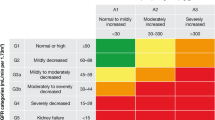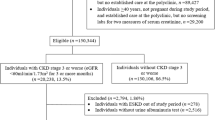Abstract
Aims
This study compared the 2009 versus 2021 chronic kidney disease (CKD) Epidemiological Collaboration (CKD-EPI) equations to calculate estimated glomerular filtration rate (eGFR) among Jordanian patients with T2DM to assess their agreement and impact on CKD staging.
Methods
This cross-sectional study included 2382 adult Jordanian patients with T2DM. The 2009 and 2021 CKD-EPI equations were used to calculate eGFR. Patients were reclassified according to kidney disease-Improving Global Outcomes (KDIGO) categories. Agreement between the equations was assessed using Bland–Altman plots and Lin’s concordance correlation.
Results
The 2021 equation significantly increased eGFR by a median of 2.1 mL/min/1.73 m2 (interquartile range: 0.6–3.6 mL/min/1.73 m2). However, there was significant agreement between equations (Kappa: 0.99; 95% confidence interval: 0.95–1.00), independent of age, sex, and the presence of hypertension. In total, 202 patients (8.5%) were reclassified to higher KDIGO categories using the 2021 equation, with category G3 being most affected. The overall prevalence of patients in the high to highest risk categories decreased (28.0% vs. 26.5%).
Conclusions
Although there was significant agreement with the 2009 equation, the 2021 equation increased eGFR and resulted in the reclassification of a subset of subjects according to KDIGO criteria. The uncertain impact of reducing high-risk category patients raises concerns about potential delays in referral and intervention, while holding the potential to enhance high-risk patient categorization, thus alleviating healthcare burden.



Similar content being viewed by others
Data availability
All data generated or analysed during this study are included in this publication article. Raw datasets are available from corresponding author and can be provided upon reasonable request.
References
Blankenberg S, Zeller T (2018) Standard and novel biomarkers. In: de Lemos JA, Omland T (eds) Chronic coronary artery disease, Amsterdam: Elsevier. pp 98–113. https://doi.org/10.1016/C2015-0-00969-8
Webster AC, Nagler EV, Morton RL, Masson P (2017) Chronic kidney disease. Lancet 389:1238–1252. https://doi.org/10.1016/S0140-6736(16)32064-5
Stevens PE, Levin A; Kidney Disease: Improving Global Outcomes Chronic Kidney Disease Guideline Development Work Group Members (2013) Evaluation and management of chronic kidney disease: synopsis of the Kidney Disease: improving Global Outcomes 2012 clinical practice guideline. Ann Intern Med. 158:825–30. https://doi.org/10.7326/0003-4819-158-11-201306040-00007
Chen TK, Knicely DH, Grams ME (2019) Chronic kidney disease diagnosis and management: a review. JAMA 322:1294–1304. https://doi.org/10.1001/jama.2019.14745
Chen TK, Sperati CJ, Thavarajah S, Grams ME (2021) Reducing kidney function decline in patients with CKD: core curriculum 2021. Am J Kidney Dis 77:969–983. https://doi.org/10.1053/j.ajkd.2020.12.022
de Boer IH, Caramori ML, Chan JCN, Heerspink HJL, Hurst C, Khunti K et al (2020) Executive summary of the 2020 KDIGO diabetes management in CKD guideline: evidence-based advances in monitoring and treatment. Kidney Int 98:839–848. https://doi.org/10.1016/j.kint.2020.06.024
Levey AS, Stevens LA, Schmid CH et al (2009) A new equation to estimate glomerular filtration rate. Ann Intern Med 150:604–612. https://doi.org/10.7326/0003-4819-150-9-200905050-00006
Inker LA, Eneanya ND, Coresh J, Tighiouart H, Wang D, Sang Y et al (2021) New creatinine-and cystatin C-based equations to estimate GFR without race. N Engl J Med 385:1737–1749. https://doi.org/10.1056/NEJMoa2102953
Delgado C, Baweja M, Burrows NR, Crews DC, Eneanya ND, Gadegbeku CA et al (2021) Reassessing the inclusion of race in diagnosing kidney diseases: an interim report from the NKF-ASN Task Force. Am J Kidney Dis 78:103–115. https://doi.org/10.1053/j.ajkd.2021.03.008
Bragg-Gresham J, Thakur JS, Jeet G, Jain S, Pal A, Prasad R et al (2020) Population-based comparison of chronic kidney disease prevalence and risk factors among adults living in the Punjab, Northern India and the USA (2013–2015). BMJ Open 10:e040444. https://doi.org/10.1136/bmjopen-2020-040444
Xu R, Zhang LX, Zhang P, Wang F, Zuo L, Wang HY (2009) Comparison of the prevalence of chronic kidney disease among different ethnicities: Beijing CKD survey and American NHANES. Nephrol Dial Transplant 24:1220–1226. https://doi.org/10.1093/ndt/gfn609
Kramer H, Palmas W, Kestenbaum B, Cushman M, Allison M, Astor B et al (2008) Chronic kidney disease prevalence estimates among racial/ethnic groups: the Multi-Ethnic Study of Atherosclerosis. Clin J Am Soc Nephrol 3:1391–1397. https://doi.org/10.2215/CJN.04160907
WHO Expert Consultation (2004) Appropriate body-mass index for Asian populations and its implications for policy and intervention strategies. Lancet 363:157–163. https://doi.org/10.1016/S0140-6736(03)15268-3
Menke A, Casagrande S, Geiss L, Cowie CC (2015) Prevalence of and trends in diabetes among adults in the United States, 1988–2012. JAMA 314:1021–1029. https://doi.org/10.1001/jama.2015.10029
Lane D, Beevers DG, Lip GYH (2002) Ethnic differences in blood pressure and the prevalence of hypertension in England. J Hum Hypertens 16:267–273. https://doi.org/10.1038/sj.jhh.1001371
Handelsman Y, Bloomgarden ZT, Grunberger G, Umpierrez G, Zimmerman RS, Bailey TS et al (2015) American association of clinical endocrinologists and american college of endocrinology: clinical practice guidelines for developing a diabetes mellitus comprehensive care plan - 2015. Endocr Pract 21:S1-87. https://doi.org/10.4158/EP15672.GL
Levey AS, Eckardt KU, Dorman NM, Christiansen SL, Hoorn EJ, Ingelfinger JR et al (2020) Nomenclature for kidney function and disease: report of a kidney disease: Improving Global Outcomes (KDIGO) Consensus Conference. Kidney Int 97:1117–1129. https://doi.org/10.1016/j.kint.2020.02.010
Stevens, P. E., Levin, A., & kidney disease: Improving Global Outcomes Chronic Kidney Disease Guideline Development Work Group Members* (2013) Evaluation and management of chronic kidney disease: synopsis of the kidney disease: improving global outcomes 2012 clinical practice guideline. Annals of internal medicine, 158(11):825–830
Lin LI (1989) A concordance correlation coefficient to evaluate reproducibility. Biometrics. https://doi.org/10.2307/2532051
Cohen J (1960) A coefficient of agreement for nominal scales. Educ Psychol Meas 20:37–46. https://doi.org/10.1177/001316446002000104
George C, Mogueo A, Okpechi I, Echouffo-Tcheugui JB, Kengne AP (2017) Chronic kidney disease in low-income to middle-income countries: the case for increased screening. BMJ Glob Health 2:e000256. https://doi.org/10.1136/bmjgh-2016-000256
George C, Echouffo-Tcheugui JB, Jaar BG, Okpechi IG, Kengne AP (2022) The need for screening, early diagnosis, and prediction of chronic kidney disease in people with diabetes in low-and middle-income countries: a review of the current literature. BMC Med 20:247. https://doi.org/10.1186/s12916-022-02438-6
Hoogeveen EK (2022) The epidemiology of diabetic kidney disease. Kidney Dial 2:433–442. https://doi.org/10.3390/kidneydial2030038
Farah R, Alhajahjeh A, Nofal A, Hyasat TB, Abu Jebbeh RAH, Suboh LT et al (2023) Clinical outcomes in patients with type 2 diabetes mellitus-related kidney disease: a Jordanian population cohort study. J Diabetes Compl 37:108478. https://doi.org/10.1016/j.jdiacomp.2023.108478
Fu EL, Coresh J, Grams ME, Clase CM, Elinder CG, Paik J et al (2023) Removing race from the CKD-EPI equation and its impact on prognosis in a predominantly white European population. Nephrol Dial Transplant 38:119–128. https://doi.org/10.1093/ndt/gfac197
Fujii R, Pattaro C, Tsuboi Y, Ishihara Y, Melotti R, Yamada H et al (2023) Comparison of glomerular filtration rate estimating formulas among Japanese adults without kidney disease. Clin Biochem 111:54–59. https://doi.org/10.1016/j.clinbiochem.2022.10.011
Khandpur S, Awasthi A, Behera MR, Purty AJ, Singh NP, Tiwari S (2022) Kidney disease burden in an Asian Indian population: effect of the new 2021 serum creatinine CKD-EPI equation. Diabetes Res Clin Pract 193:110120. https://doi.org/10.1016/j.diabres.2022.110120
Ronny SSF, Joaniter NI, Robert K, Bonnie W, Bruce K, James K et al (2022) Comparison of the prevalence of kidney disease by proteinuria and decreased estimated glomerular filtration rate determined using three creatinine-based equations among patients admitted on medical wards of Masaka Regional Referral Hospital in Uganda: a prospective study. BMC Nephrol 23:242. https://doi.org/10.1186/s12882-022-02865-w
Bukabau JB, Yayo E, Gnionsahé A, Monnet D, Pottel H, Cavalier E et al (2019) Performance of creatinine- or cystatin C-based equations to estimate glomerular filtration rate in sub-Saharan African populations. Kidney Int 95:1181–1189. https://doi.org/10.1016/j.kint.2018.11.045
Gregg LP, Richardson PA, Akeroyd J, Matheny ME, Virani SS, Navaneethan SD (2022) Effects of the 2021 CKD-EPI creatinine eGFR equation among a national US veteran cohort. Clin J Am Soc Nephrol 17:283–285. https://doi.org/10.2215/CJN.10000721
Vestergaard SV, Heide-Jørgensen U, Birn H, Christiansen CF (2022) Effect of the refitted race-free eGFR formula on the CKD prevalence and mortality in the Danish population. Clin J Am Soc Nephrol 17:426–428. https://doi.org/10.2215/CJN.14491121
Jiang S, Zhang D, Li W (2022) The Chronic Kidney Disease Epidemiology Collaboration equations perform less well in an older population with type diabetes than their non-diabetic counterparts. Front Public Health 10:952899. https://doi.org/10.3389/fpubh.2022.952899
Zafari N, Churilov L, Wong L, Lotfaliany M, Hachem M, Kiburg KV et al (2021) Evaluation of the diagnostic performance of the creatinine-based Chronic Kidney Disease Epidemiology Collaboration equation in people with diabetes: a systematic review. Diabet Med 38:e14391
Moazzeni SS, Arani RH, Hasheminia M, Tohidi M, Azizi F, Hadaegh F (2021) High incidence of chronic kidney disease among Iranian diabetic adults: using CKD-EPI and MDRD equations for estimated glomerular filtration rate. Diabetes Metab J 45:684–697. https://doi.org/10.4093/dmj.2020.0109
Sprangers B, Evenepoel P, Vanrenterghem Y (2006) Late referral of patients with chronic kidney disease: no time to waste. Mayo Clin Proc 81:1487–1494. https://doi.org/10.4065/81.11.1487
Acknowledgements
The authors cordially thank the participants of this study and all those who supported this project for their valuable time and contributions to this research.
Funding
This research did not receive any specific grant from funding agencies in the public, commercial, or not-for-profit sectors.
Author information
Authors and Affiliations
Corresponding author
Ethics declarations
Conflict of interest
The authors declare that they have no conflicts of interest.
Consent for publication
The requirement of obtaining informed consent for publication was waived for this study owing to its retrospective nature.
Ethical approval
This study was approved by the institutional review boards of Jordan University Hospital and the National Centre for Diabetes, Endocrinology and Genetics in Amman, Jordan. All procedures performed during this research were in accordance with the ethical principles outlined in the World Medical Association’s revised Declaration of Helsinki.
Additional information
Publisher's Note
Springer Nature remains neutral with regard to jurisdictional claims in published maps and institutional affiliations.
This article belongs to the topical collection Diabetic Nephropathy, managed by Giuseppe Pugliese.
Rights and permissions
Springer Nature or its licensor (e.g. a society or other partner) holds exclusive rights to this article under a publishing agreement with the author(s) or other rightsholder(s); author self-archiving of the accepted manuscript version of this article is solely governed by the terms of such publishing agreement and applicable law.
About this article
Cite this article
Farah, R.I., Alhajahjeh, A., Al-farahid, O. et al. Comparison and evaluation of the 2009 and 2021 chronic kidney disease-epidemiological collaboration equations among Jordanian patients with type 2 diabetes mellitus. Acta Diabetol 61, 169–180 (2024). https://doi.org/10.1007/s00592-023-02191-z
Received:
Accepted:
Published:
Issue Date:
DOI: https://doi.org/10.1007/s00592-023-02191-z




